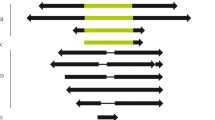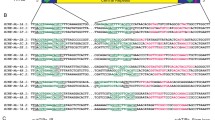Summary
Two P-elements (bif1 and bif2) were isolated from a genomic library ofDrosophila bifasciata. Both elements are internally deleted and have lost the coding capacity for a functional transposase. One of the elements (bif2) contains an insert consisting of a repetitive sequence. The terminal inverted repeats and the segments necessary for passive mobility are well conserved. Element bif2 has retained rudiments of the coding sequence of exon 0 and exon 3, but the reading frame is destroyed by insertions and deletions. The comparison of theD. bifasciata P-elements with P-elements ofDrosophila melanogaster andDrosophila nebulosa reveals that the two latter sequences are more similar to each other than either of them is to theD. bifasciata elements. This finding contradicts the phylogenetic relationship of the species and can be taken as an indirect but unequivocal evidence for recent horizontal gene transfer from a relative ofD. nebulosa to the gene pool ofD. melanogaster. The P-elements ofD. bifasciata are phylogenetically ancient and have evolved independently for about 50 million years. A higher substitution rate at the third codon position as well as a predominance of conservative replacements at the amino acid level indicates that the P-elements ofD. bifasciata have been under selective constraint over a long period and that immobilization has occurred only recently.
Similar content being viewed by others
References
Anxolabéhère D, Nouaud D, Périquet G (1985) Séquences homologues á l'élément P chez de espècesDrosophila du groupeobscura et chezScaptomyca pallida (Drosophilidae). Génét Sél Evol 17:579–584
Anxolabéhère D, Kidwell MG, Périquet G (1988) Molecular characteristics of diverse populations are consistent with the hypothesis of recent invasion ofD. melanogaster by mobile P elements. Mol Biol Evol 5:252–269
Beverly SM, Wilson AC (1984) Molecular evolution inDrosophila and the higher Diptera II. A time scale for fly evolution. J Mol Evol 21:1–13
Bingham PM, Kidwell MG, Rubin GM (1982) The molecular basis of P-M hybrid dysgenesis: the role of the P element, a P-strain-specific transposon family. Cell 29:995–1004
Brookfield JFY, Montgomery E, Langley CH (1984) Apparent absence of transposable elements related to the P elements ofD. melanogaster in other species ofDrosophila. Nature 310: 330–332
Chen EY, Seeburg PM (1985) Supercoil sequencing: a fast and simple method for sequencing plasmid DNA. DNA 4:165–170
Daniels SB, Strausbaugh LD (1986) The distribution of P-element sequences inDrosophila: thewillistoni andsaltans species groups. J Mol Evol 23:138–148
Daniels SB, Peterson KR, Strausbaugh LD, Kidwell MG, Chovnick A (1990) Evidence for horizontal transmission of the P transposable element betweenDrosophila species. Genetics 124:339–355
Dellaporta SL, Wood J, Hicks B (1983) Plant DNA minipreparation: version II. Plant Mol Biol Rep 1:19–21
Engels WR (1989) P-elements inD. melanogaster. In: Berg DE, Howe MM (eds) Mobile DNA. American Society for Microbiology, Washington, pp 437–484
Felger I, Pinsker W (1987) Histone gene transposition in the phylogeny of theDrosophila obscura group. Z Zool Syst Evolutionsforsch 25:127–140
Frischauf AM, Lehrach H, Poustka A, Murray N (1983) Lambda replacement vectors carrying polylinker sequence. J Mol Biol 170:827–842
Grantham R (1974) Amino acid difference formula to help explain protein evolution. Science 185:862–864
Henikoff S (1984) Unidirectional digestion with exonuclease III creates target breakpoints for DNA sequencing. Gene 28:351–359
Jukes TH, Cantor CR (1969) Evolution of protein molecules. In: Munro HN (ed) Mammalian protein metabolism III. Academic Press, New York, pp 21–132
Kidwell MG (1983) Evolution of hybrid dysgenesis determinants inD. melanogaster. Proc Natl Acad Sci USA 80:1655–1659
Kidwell MG, Kidwell JF, Sved JA (1977) Hybrid dysgenesis inD. melanogaster: a syndrome of aberrant traits including mutation, sterility and male recombination. Genetics 86:813–833
Lakovaara S, Saura A, Lankinen P, Pohjola L, Lokki J (1976) The use of isozymes in tracing evolution and in classifying Drosophilidae. Zool Scr 5:173–179
Lansman RA, Stacey SN, Grigliatti TA, Brock HW (1985) Sequences homologous to the P mobile element ofD. melanogaster are widely distributed in the subgenusSophophora. Nature 318:561–563
Lansman RA, Shade RO, Grigliatti TA, Brock HW (1987) Evolution of P transposable elements: sequences ofD. nebulosa P elements. Proc Natl Acad Sci USA 84:6491–6495
Li WH, Luo CC, Wu CI (1985) Evolution of DNA sequences. In: MacIntyre RJ (ed) Molecular evolutionary genetics. Plenum Press, New York, pp 1–94
Maniatis T, Fritsch EF, Sambrook J (1982) Molecular cloning. Cold Spring Harbor Laboratory, Cold Spring Harbor NY
O'Hare K, Rubin GM (1983) Structures of P transposable elements and their sites of insertion and excision in theD. melanogaster genome. Cell 34:25–35
Rubin GM, Spradling AC (1982) Genetic transformation ofDrosophila with transposable element vectors. Science 218: 348–353
Saura A (1974) Genetic variation in Scandinavian populations ofD. bifasciata. Hereditas 76:161–172
Tabor S, Richardson CC (1987) DNA sequence analysis with modified bacteriophage T7 DNA polymerase. Proc Natl Acad Sci USA 84:4767–4771
Throckmorton LH (1975) The phylogeny, ecology and geography ofDrosophila. In: King RC (ed) Handbook of genetics, vol 3. Plenum Press, New York, pp 421–469
Author information
Authors and Affiliations
Rights and permissions
About this article
Cite this article
Hagemann, S., Miller, W.J. & Pinsker, W. P-related sequences inDrosophila bifasciata: A molecular clue to the understanding of P-element evolution in the genusDrosophila . J Mol Evol 31, 478–484 (1990). https://doi.org/10.1007/BF02102074
Received:
Revised:
Issue Date:
DOI: https://doi.org/10.1007/BF02102074




